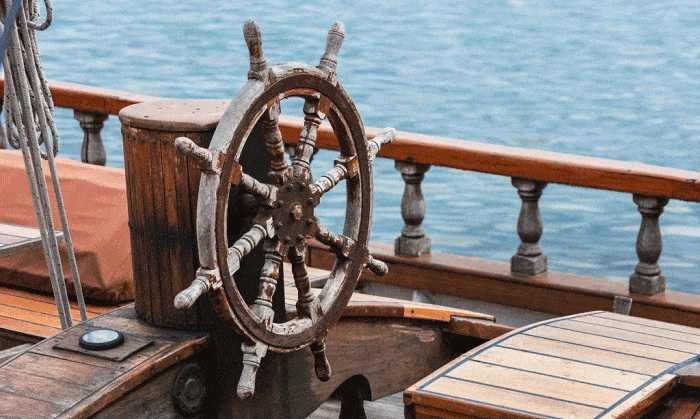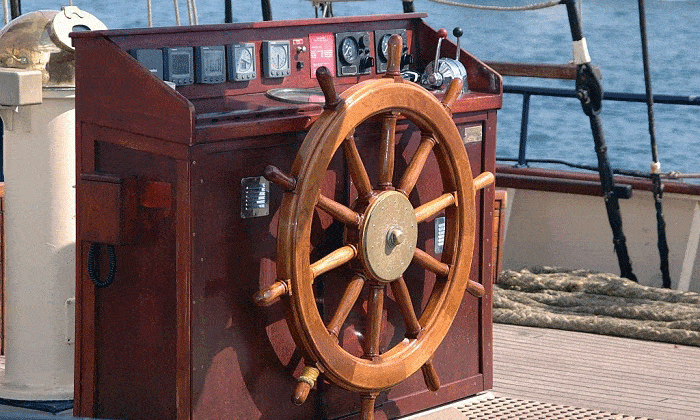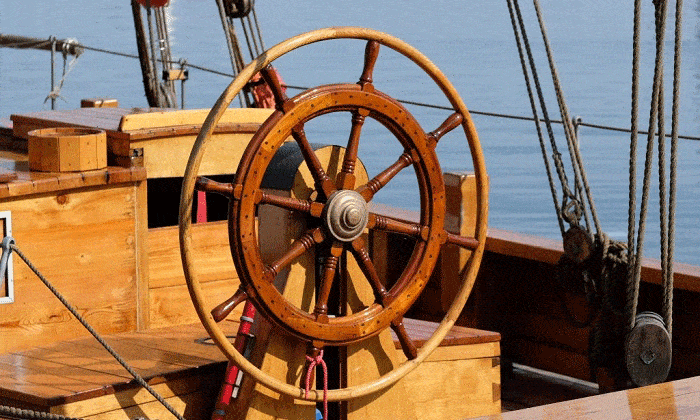The wheel is essential for controlling the boat, and there are multiple things to learn about it. But, what is the steering wheel on a ship called? It is, in fact, an interesting point that many boaters might be curious about.
In this article, we’ll take a good look at the wheel and how to control boats and ships. We’ll take a closer look at how ships are controlled, including some other important information about taking the helm of a ship.
Table of Contents
The Steering Wheel of Boats and Ships
The steering wheel is commonly used not only for boats today but also for other types of vehicles. It is a control mechanism that is easy to operate, making its wide use advantageous for accessibility. Most modern boats and ships these days make use of a wheel, although some boats make use of a tiller.
Ships also make use of the wheel. But what is it called, and how is it different from a boat steering wheel name?
The Steering Wheel of a Ship Name
The steering wheel used on boats is called the boat wheel and the ship steering wheel name is the ship wheel. It’s more common to refer to the wheel of ships as the helm though a boat steering wheel called helm is not uncommon. To take the helm of a boat or ship means to take control of it.
However, the helm also refers to the area of the boat or ship from where the ship is controlled. Besides the wheel, other important parts are located at the helm, including tools for navigation and communication. Due to the size of ships, however, the helm is usually located in a much bigger area dedicated for controlling the entire vessel, the bridge.
The Steering Wheel – How It Works
The wheel is used to steer the boat in a specific direction. By turning the steering wheel of a ship or boat, we can adjust which direction the vessel goes. The wheel itself is connected to the rudder which directly affects the ship’s direction.
In old boats and ships, the helm is located near the stern of the vessel for easy connecting to the rudder. For controlling the vessel from the helm, the area is kept at an elevation that makes the surroundings more visible. It is especially important to have a clear view of the ship’s bow when helming the boat or ship.
In modern boats and ships, the helm can be found further from the stern. It is due to the advancement in technology which allows the wheel to be further from the rudder without affecting the stability of the control system. Much bigger ships may also have the bridge elevated at a much higher position to properly survey a larger area surrounding the ship.
The Rudder
Turning the steering wheel adjusts the rudder, thus steering the direction of the ship. The rudder itself is like a fin located underwater at the ship’s stern. The ship’s keel guides the flow of water toward the stern, and the rudder changes the direction of the vessel depending on its angle.
Rudders are placed at the stern of the ship and in vessels that use motors. More importantly, rudders are placed behind the propeller to maximize its performance.
There are various rudder designs, and some vessels make use of multiple rudders. Even large ships still utilize rudders, but the ship weight makes it difficult for rudders to do their job. While larger rudders are a given on large vessels, more specialized designs are installed for effective and efficient use.
Modern Ship Control
The challenge in controlling and steering modern ships has to do with their size and weight. Old ships relied on the strength of the helmsman to steer towards the right direction, as the resistance created by the flow of water against the rudder makes the ship wheel heavy.
Modern ships utilize a hydraulic steering system, with the wheel as means of changing the ship’s direction. Because ships must respond to changes in the surrounding area on time, it is necessary to have a specific response time for turning. This means that the rudder needs adjusment from one side to the other within a specific time frame.
Ensuring a specific response time for turning the large rudder of the ship, providing fail-safe for specific emergencies, combating the resistance created by the flow of water against the ship’s rudder. These are just some of the things that the hydraulic steering system of a ship addresses.
With modern hydraulic steering, even a ship weighing thousands of tonnes can be steered by a single person. However, these complex mechanisms including the management of these systems demand a crew of experts and engineers.
The Tiller – Alternative to the Wheel
Instead of using a steering wheel, some boats use the tiller to control the rudder. The tiller is a long rod or level. It is usually made of wood or metal, which can be turned side-to-side to change the angle of the rudder.
In the past, tillers were commonly used for both boats and ships. Tillers used in ships were fairly large, and these large tillers could be heavy enough to need multiple people to steer the ship. Such large tillers could be found beneath the deck instead of on it to directly connect to the rudder without risk of malfunction.
Modern boats may still have tillers, but they are only usually found in smaller vessels. Larger boats reaching 30 feet in length or longer do not use a tiller.
Advantages of a Tiller
First of all, it saves a lot of space on the boat. Boat wheels take up a lot of space, so the tiller, mounted at the stern of the boat, takes up no space. Hence, using it makes excellent sense for small boats.
Tillers are also much more responsive and accurate compared to the boat wheel. Also, the tiller is directly connected to the rudder, any changes made to the rudder through the tiller results in an immediate response. While tillers lose this responsiveness at faster speeds, its accuracy at slower speeds is unparalleled, thus ideal for fishing and trolling.
How Tillers Work
As mentioned earlier, tillers are usually directly connected to the rudder. They can also be connected to a shaft instead, and the rudder connects to the same shaft below the water. In either case, the tiller retains its superb control of the boat.
The biggest difference between the tiller and the wheel is how they turn. Unlike the wheel, the tiller turns the boat in the opposite direction the tiller. Turning the tiller right will move the direction of the boat to the left.
The simplicity of the tiller’s mechanism makes it easy to operate the boat. Tillers have such a large advantage for certain activities that it is still widely used.
Conclusion
What is the steering wheel on a ship called? After reading this article, you now have a better understanding of the wheel including what to call the steering wheel on a ship. You are also more familiar with both the wheel and the tiller including the rudder of boats.
Please also leave your comments and suggestions below. We’d very much like to hear from you.
Remember to boat safely.

“My intention from the first day establishing Boating Basics Online is to provide as much help as possible for boaters who want to experience a first safe and convenient trip. So feel free to join us and share your beautiful journeys to the sea!”



